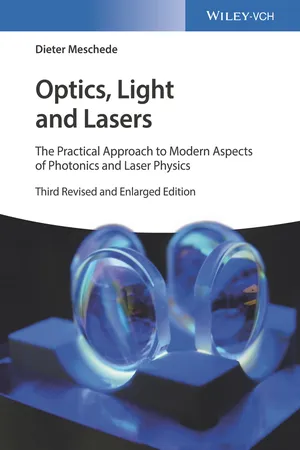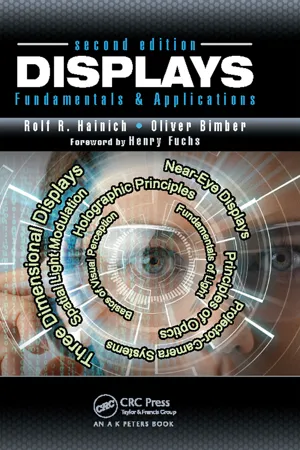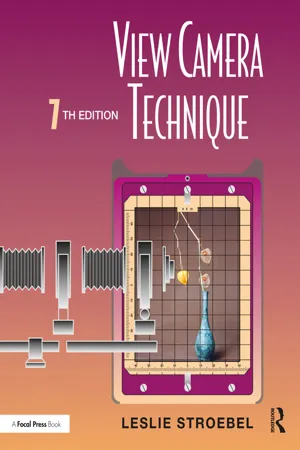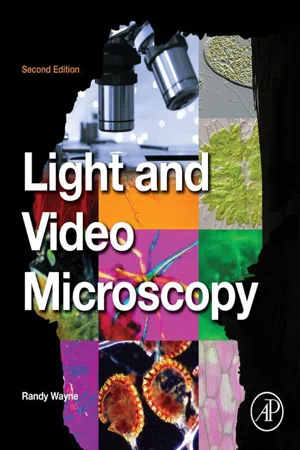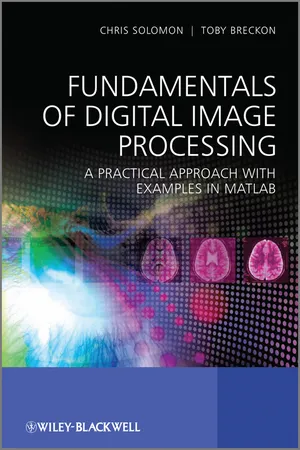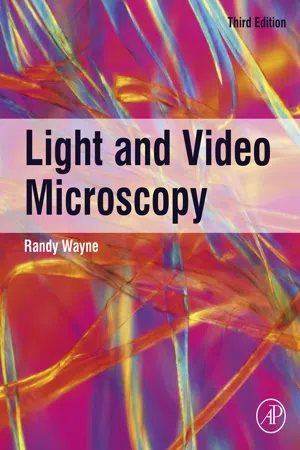Physics
Image Formation by Lenses
Image formation by lenses occurs when light rays pass through a lens and converge or diverge to create a real or virtual image. Lenses can be convex or concave, and the type of image formed depends on the object's distance from the lens and the lens's focal length. Convex lenses produce real or virtual images, while concave lenses produce only virtual images.
Written by Perlego with AI-assistance
Related key terms
1 of 4
Related key terms
1 of 3
9 Key excerpts on "Image Formation by Lenses"
- eBook - ePub
Optics, Light and Lasers
The Practical Approach to Modern Aspects of Photonics and Laser Physics
- Dieter Meschede(Author)
- 2017(Publication Date)
- Wiley-VCH(Publisher)
Chapter 5 Optical ImagesThis chapter is dedicated to the basic principles of optical image formation. Imaging by lenses and lens systems is the basis for optical instruments, which have substantially influenced the development of optics and have made possible – literally – our insights into the macro- and micro-cosmos.The basic element in optical imaging is the convex lens, which for stigmatic imaging merges into one point again all the rays that originated from a single point. Systems of lenses let us build microscopes, telescopes, and numerous other instruments to peek into the worlds not directly accessible with our eyes. Imaging occurs as well with the lens of our eye; thus we need to account the properties of our “own vision instrument” to understand image formation.In addition to the basic principles, we raise the question of the resolution capability of such instruments. What objects at very large distances can we make visible? What are the smallest objects that we can observe with a microscope including their structure or at least their size?5.1 Simple Lenses
With the help of geometry, we can understand the most important properties of a (real and virtual) optical image (Figure 5.1 ):- A beam parallel to the axis is sent through the focal point by a convex lens.
- A beam that reaches the lens via the focal point leaves the lens parallel to the axis.
- A beam passing through the center of the lens is not diffracted.
Let us summarize selected relations and leave the justification to the reader.Conventional construction of a lens image with the common notation. : object and image size; : focal length with identical lengths.Figure 5.1- Real and virtual images. In Figure 5.1 formation of a real image is shown: all rays emanating from an object point are reconvened at a single image point (stigmatic imaging). All rays have identical optical path lengths (Section 1.8.1 ). The image can be recorded by, for example, a camera sensor at the image position. Note that for acceptable imaging, this condition needs to be fulfilled ideally for all image points and for all rays, a requirement that can only be achieved approximately.
In contrast, in Figure 5.2 , formation of a virtual image is illustrated. The focal lengths of the diverging lens are counted negative with respect to the object–lens axis. Otherwise the construction principles of p. 149 remain. The virtual image seems to emerge from
- eBook - ePub
- Michael M. Mansfield, Colm O'Sullivan(Authors)
- 2020(Publication Date)
- Wiley(Publisher)
paraxial rays).From Figure 23.23 , that is,δ ∝ hand since, from Equation (23.5) ,δ ∝ Awe see that the criterion for a point image (all rays from S passing through I) is that A be directly proportional to h. The image formation device so constructed is an example of a lens, similar to that known as a Fresnel lens, originally developed for lighthouses and now commonly used in automobile headlights, overhead projectors, projection televisions, low‐cost magnifying glasses, etc.The power of a lens is defined as the angular deviation per unit distance from the axis, that isThus,and the position of the image of a point source at a distance x from the centre of the lens is given by .From the definition, the SI unit of lens power is radm−1, known as the dioptre and denoted by the symbol D.23.6 Image formation by spherical lenses
Spherical lenses form part of many everyday objects such as reading glasses, magnifying glasses, binoculars, etc. or scientific instruments such as microscopes and telescopes. As we shall see, image formation in spherical lenses can occur in a similar way to that discussed in the previous section. Consider, as an example, the double convex (bi‐convex) lens shown in Figure 23.24 . The left‐hand face is part of a sphere of radiusρ1with the centre of curvature atC1while the right‐hand face has radius of curvatureρ2with centre atC2. In the figure, the radii of curvature are shown as measured to the centre of the lens rather than to the corresponding faces; since all lenses to be discussed are thin, this approximation has negligible consequences.Geometrical features of a double convex lens.Figure 23.24The dashed lines which have been drawn perpendicular to each face in Figure 23.24 have to pass through the corresponding centres of curvature. The angle A between these lines (each normal to the surface of a face) is the same as the angle between the corresponding tangent lines drawn at the same points. A sufficiently small horizontal slice (shaded element in the figure) will behave like an element (thin prism) of the lens discussed in the previous section. Inspecting theΔ C1 DC2 - eBook - ePub
Displays
Fundamentals & Applications, Second Edition
- Rolf R. Hainich, Oliver Bimber(Authors)
- 2016(Publication Date)
- A K Peters/CRC Press(Publisher)
real. If light rays do not really intersect within a point (e.g., if they diverge after leaving the optical system), they can still form virtual images, because these rays appear to diverge from points inside the optical system. The location of the virtual image is found by extending the light rays in negative direction. As this portion of the optical path is negative, it must be subtracted from the total path length. Objects can also be virtual. In this case, the light rays again have to be extended in order to find the location of the corresponding object. The subpath to a virtual object also has to be subtracted from the total path length.FIGURE 3.13 Point image formation with an optical system S: real object and image (top), real object and virtual image (center), virtual object and virtual image (bottom). The general equation for optical path length.Producing absolute optical systems is difficult, because the only surfaces that are easy to build and that support stigmatism are planar or spherical surfaces. Most optical instruments just approximate stigmatic image formation. The deviation from the ideal image introduced by this imperfection is called aberration.Recent developments have enabled the manufacturing of aspherical or even asymmetric optical surfaces (free-form optics) [245 ]. Among the applications especially profiting from this are several types of near-eye displays (NEDs).Below, we will review how reflective and refraction optical elements form optical images. 3.4.1 Reflective OpticsConsider an optical system exclusively made up of reflecting surfaces (e.g., mirrors). Further conceptualize that the mirrors are surrounded by air or, at least, that the medium the light rays are traveling through is ordinary. - eBook - ePub
- Leslie Stroebel(Author)
- 1999(Publication Date)
- Routledge(Publisher)
3 Image FormationAlmost any lens that can be attached to a lens board, including a pinhole aperture, can be used on a view camera, but for most picture-taking situations lenses specifically designed for view cameras should be used. Considering the many ways in which lenses can differ, photographers often have little specific information about the lenses that they purchase and use. Not infrequently, the focal length and f -number of the maximum aperture are the only quantitative information marked on the lens barrel (with the full set of f -numbers and shutter speeds appearing on the shutter housing). Since relatively few photographers are prepared to conduct comprehensive lens tests, they tend to be influenced in their choice of lenses by recommendations of others and the manufacturers’ advertising claims. Although the major lens manufacturers do make testing and performance data available in their technical publications, some of the characteristics of the images formed by view camera lenses are difficult to document in terms that are meaningful to photographers who have no knowledge of optics. A basic knowledge of image formation is also helpful in understanding the limitations of view camera swings, tilts, and other adjustments to prevent unnecessary loss of quality of the optical image.Some of the more significant ways in which the images formed by different lenses may vary are image size, image illumination at the maximum aperture, variations of illumination from the center to the edges of the film, image definition at the center and edges of the film, image definition when focused on near and far object distances, and accuracy of the image with respect to shape, color, and contrast.3.1 Image Formation with a PinholeThe simplest method for forming an optical image is with a pinhole in a thin sheet of opaque material. The pinhole can be thought of as transmitting only a single ray of light from each point on the subject, which, since light travels in a straight line in air, can strike only one position on a ground-glass viewing surface or piece of film placed behind the pinhole. The size of the inverted image increases with the distance between the pinhole and the ground glass or film, as shown in Figure 3-1 . Instead of a single ray of light, the pinhole actually transmits a very narrow beam of light, one that has the same diameter as the pinhole, from each object point. It would seem logical that the sharpness of the pinhole image would vary inversely with the size of the pinhole, but for a given pinhole-to-film distance there is an optimum pinhole size. If the pinhole is made larger than the optimum size, it transmits too large a beam of light, which reduces image sharpness. If the pinhole is made smaller than the optimum size, it causes the narrow beam to spread out (somewhat like water from the nozzle on a garden hose) due to a phenomenon known as diffraction, - eBook - ePub
- Randy O. Wayne(Author)
- 2013(Publication Date)
- Academic Press(Publisher)
Chapter 3The Dependence of Image Formation on the Nature of Light
In this chapter I discuss the dependence of image formation on the nature of light itself. Geometrical optics is no longer sufficient to predict the relationship between the object and the image when the object’s size approaches the wavelength of light because the object diffracts the incident light. Since diffraction is significant when the details in an object are similar in size to the wavelength of light, we need to understand the interaction of light with matter to predict the relationship between the object and the image formed by diffracted light. This is the realm of physical optics, which is based on the wave theory of light. I discuss the development of the wave theory of light by Huygens, Young, Fresnel, and Maxwell. I also discuss how Ernst Abbe developed a theory of image formation where the diffraction of light limits the resolving power of the light microscope.Newton Newton was taking a walk. Death had followed him, Strumming his guitar. Newton was taking a walk. The worms gnawed through his apple …. Newton wept.Keywords
Abbe; Diffraction; Fresnel; Huygens; Interference; Maxwell; Resolution; Waves; YoungFrederico García Lorca (2001)In the last chapter I discussed geometric optics and the corpuscular theory of light. In this chapter I will discuss physical optics and the wave theory of light. Geometric optics is sufficient for understanding image formation when the objects are much larger than the wavelength of light. However, when the characteristic length of the object approaches the wavelength of light, we need the principles of physical optics, developed in this chapter, to understand image formation.Christiaan Huygens and the Invention of the Wave Theory of Light
Up until now, we have assumed that light travels as infinitesimally small corpuscles along infinitesimally thin rays. This hypothesis has been very productive, having allowed us to predict the position, orientation, and magnification of images formed by mirrors and lenses. In the words of Christiaan Huygens (1690) - eBook - ePub
- R.A. Edwards(Author)
- 2014(Publication Date)
- Pergamon(Publisher)
(21.4) together give(21.5)which is of exactly the same form as the formula used for spherical mirrors. Here f is positive for a converging lens in air and negative for a diverging lens in air.21.3 Image Formation by Lenses
For locating image positions in the case of lenses similar scale drawings may be constructed as in the case of spherical mirrors provided that we imagine that we are dealing with rays near to the principal axis which make small angles with it. In particular it should be noted that a ray passing through the centre of a lens may be supposed to suffer no deviation since it is passing through what is virtually a parallel-sided, thin, rectangular block of the material (Fig. 21.8 ). There will be some sideways displacement, but this is negligible since the lens is supposed thin and the angle of incidence small. Thus for constructing scale drawings the following rules apply:FIG. 21.8(i) Since the lens is to be regarded as thin, all rays must be drawn to a line perpendicular to the axis passing through the centre of the lens. (The curved surfaces of the lens are drawn in only as a diagrammatic representation of the lens.) - eBook - ePub
Fundamentals of Digital Image Processing
A Practical Approach with Examples in Matlab
- Chris Solomon, Toby Breckon(Authors)
- 2011(Publication Date)
- Wiley(Publisher)
Convolution operator * A mathematical operation which ‘smears’ (i.e. convolves) one function with another.Figure 2.1 An overview of the image formation ‘system’ and the effect of the PSFHere, the function of the light reflected from the object/scene (object function ) is transformed into the image data representation by convolution with the PSF. This function characterizes the image formation (or capture) process. The process is affected by noise.The PSF is a characteristic of the imaging instrument (i.e. camera). It represents the response of the system to a point source in the object plane, as shown in Figure 2.1 , where we can also consider an imaging system as an input distribution (scene light) to output distribution (image pixels) mapping function consisting both of the PSF itself and additive noise (Figure 2.1 (lower)).From this overview we will consider both the mathematical representation of the image formation process (Section 2.2), useful as a basis for our later consideration of advanced image-processing representations (Chapter 5), and from an engineering perspective in terms of physical camera imaging (Section 2.3).2.2 The mathematics of image formationThe formation process of an image can be represented mathematically. In our later consideration of various processing approaches (see Chapters 3—6) this allows us to reason mathematically using knowledge of the conditions under which the image originates.2.2.1 IntroductionIn a general mathematical sense, we may view image formation as a process which transforms an input distribution into an output distribution. Thus, a simple lens may be viewed as a ‘system’ that transforms a spatial distribution of light in one domain (the object plane) to a distribution in another (the image plane). Similarly, a medical ultrasound imaging system transforms a set of spatially distributed acoustic reflection values into a corresponding set of intensity signals which are visually displayed as a grey-scale intensity image. Whatever the specific physical nature of the input and output distributions, the concept of a mapping between an input distribution (the thing you want to investigate, see or visualize) and an output distribution (what you actually measure or produce with your system) is valid. The systems theory approach to imaging is a simple and convenient way of conceptualizing the imaging process. Any imaging device is a system, or a ‘black box’, whose properties are defined by the way in which an input distribution is mapped to an output distribution. Figure 2.2 - eBook - ePub
- Randy O. Wayne(Author)
- 2019(Publication Date)
- Academic Press(Publisher)
i2 ).Fig. 2.27 Image formation by two converging lenses separated by a distance smaller than either of their focal lengths.Now consider ray 1. It travels through the center of lens 2 and thus does not deviate—it is as if lens 2 were not there. However, we do not know the angle that ray 1 makes as it goes through lens 1 or lens 2. So, imagine that lens 2 is not there and construct two characteristic rays: one that strikes the lens after it passes through the focus (f o1 ), and one that passes through the center of lens 1 (Fig. 2.28 ). These two characteristic rays converge at P 2 ′.Fig. 2.28 Finding the image produced by the first lens of the pair shown in Fig. 2.26 , if the second lens were not there and deducing the ray that would go through the center of the second lens if it were there.Now we can easily construct ray 1 by tracing it backward from P 2 ′. through O 2 through L 1 to S 2 . We can also draw ray 1 on the original figure where we easily drew ray 2 and see where ray 1 and ray 2 converge. This is where the image is. It is real, inverted, and minified.Just like we can determine the characteristics of images formed by mirrors and single lenses analytically, we can determine the position of images formed by compound lenses analytically with the aid of the following equation:s i=f 2d −f 1f 2s o/s o−f 1d −f 2−f 1s o/s o−f 1where s o is the usual object distance (in m), s i is the usual image distance (in m), f 1 is the focal length of lens 1 (in m), f 2 is the focal length of lens 2 (in m), and d is the distance between the two lenses (in m).The total transverse magnification (m Total ) of the optical system is given by the product of the magnification due to lens 1 and the magnification due to lens 2.m Total=mT 1mT 2Thus the first lens produces an intermediate image of magnification mT1 , which is magnified by the second lens by mT2 - eBook - ePub
- Jeremy Sanderson(Author)
- 2019(Publication Date)
- Wiley(Publisher)
Abbe realised that it is not valid to assume that microscope image formation follows the same (geometric) laws as the imaging of large objects by a telescope or a photographic camera. He concluded that, upon interacting with the specimen, light was diffracted from the incident axial illuminating beam into the entire aperture of the objective and a diffraction pattern of the object formed (Figure 10.17) in the back focal plane of the objective. Figure 10.17 Image formation in the microscope Image formation in the light microscope. The direct and diffracted beams (zero and higher orders) enter the aperture of the objective and are brought to a focus at the back focal plane of the objective, where a diffraction pattern – the Fourier transform of the image (i.e. in frequency space) – is formed. The rays continue onwards to form an image when the direct beam and diffracted orders recombine and interfere to form the primary image at the primary image plane. Compare this to Figure 10.11. Source: Adapted from Bradbury and Bracegirdle 1998 with permission from Taylor & Francis Group and adapted from Bradbury 1984 with permission from Oxford University Press. Abbe related resolving power (the minimum resolved distance, MRD) to wavelength, λ, the refractive index, n, of the medium between objective and object/sample and the semi-angle, α, of the angular aperture of the objective by the expression: d = λ /2 n.sin α. He showed that for image resolution, the zero-order and at least the first order have to enter the objective lens. If the image is unresolved, that is not to say that the image is not formed. It is formed but sufficient fine detail is not seen
Index pages curate the most relevant extracts from our library of academic textbooks. They’ve been created using an in-house natural language model (NLM), each adding context and meaning to key research topics.
Explore more topic indexes
Explore more topic indexes
1 of 6
Explore more topic indexes
1 of 4
